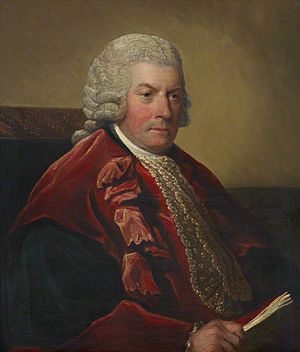Ilay Campbell, Lord Succoth facts for kids
Quick facts for kids
The Much Honoured
Lord Succoth
|
|
|---|---|

Portrait by David Martin
|
|
| Lord President of the Court of Session Lord Justice General |
|
| In office 26 October 1789 – 31 August 1808 |
|
| Appointed by | George III |
| Preceded by | Lord Glenlee |
| Succeeded by | Robert Blair |
| Member of Parliament for Glasgow Burghs | |
| In office 1784–1790 |
|
| Preceded by | John Craufurd |
| Succeeded by | John Craufurd |
| Lord Advocate | |
| In office 1784–1790 |
|
| Preceded by | The Hon Henry Erskine |
| Succeeded by | Robert Dundas |
| Solicitor General for Scotland | |
| In office 1783–1784 |
|
| Preceded by | Alexander Murray |
| Succeeded by | Robert Blair |
| Personal details | |
| Born | 1734 |
| Died | 1823 (aged 89) |
| Political party | Pittite |
| Profession | Advocate, Judge, Politician |
Sir Ilay Campbell, 1st Baronet, Lord Succoth (1734–1823) was an important Scottish lawyer, judge, and politician. He was also known as Lord Succoth. He rose to become the top judge in Scotland. This role is called the Lord President of the Court of Session.
Contents
Life of Sir Ilay Campbell
Early Life and Education
Sir Ilay Campbell was born in 1734. His birthplace was either Argyll or Edinburgh, Scotland. His father, Archibald Campbell, worked as a chief clerk for the Scottish Courts. His mother was Helen Wallace.
Ilay went to Mundell's School in Edinburgh. After that, he studied law at the University of Glasgow. He finished his studies in 1751.
Legal and Political Career
In 1757, Ilay Campbell became an advocate. An advocate is a type of lawyer who speaks for people in court. He worked on a big legal case called the Douglas peerage case from 1764 to 1769.
He was appointed Solicitor General for Scotland in 1783. This role is a senior legal advisor to the government. In 1784, he became the Lord Advocate. This is the chief legal officer for Scotland. In the same year, he also became a Member of Parliament for Glasgow Burghs. This meant he helped make laws in the British Parliament.
Lord President of the Court of Session
From 1789 to 1808, Sir Ilay Campbell held the highest judicial position in Scotland. He was the Lord President of the Court of Session and Lord Justice General. In this role, he was known as Lord Succoth. He led the main civil court in Scotland.
Later Life and Legacy
When he retired in 1808, he was given the special title of a baronet. This meant he became Sir Ilay Campbell, 1st Baronet. He then lived at Garscube House. This house was near Glasgow, by the River Kelvin. He spent his time managing his land and being a respected country gentleman. People said he was a kind and welcoming person.
The University of Glasgow gave him an honorary degree in 1784. This was a special award for his achievements. He was also elected Lord Rector of the university in 1799. He passed away at Garscube in 1823, at 89 years old.
His son, Archibald, followed in his footsteps. He also became a judge and was known as Lord Succoth. The title "Lord Succoth" was used because they were judges, not because it was passed down through the family. The family continued to have the baronet title until 2017.
Family Life
Sir Ilay Campbell married Susan Mary Murray in 1766. She was the sister of another important legal figure, Alexander Murray, Lord Henderland. Susan lived until 1815.
- Their daughter, Margaret Campbell, married Sir John Connell. He was a judge in the Admiralty Court.
- Their grandson, Arthur Connell, was a chemist. He is famous for discovering a mineral called connellite.
- Another daughter, Elizabeth Campbell, passed away in 1853. She married William Dalziell Colquhoun.
- Their daughter Mary Frances Campbell died in 1870. She never married. These two sisters are buried in Dean Cemetery.
- Their daughter Susan married Crauford Tait. Their son, Archibald Campbell Tait, became the Archbishop of Canterbury. This is a very important religious leader in England.
Notable Positions and Memberships
Sir Ilay Campbell was involved in many important groups and projects:
- He was a founder member of the Royal Society of Edinburgh in 1783. This is a famous society for science and learning.
- He was a director of the Highland Society in 1784. This group helped people in the Scottish Highlands.
- He was a trustee for the University of Edinburgh. He also helped with the South Bridge project.

